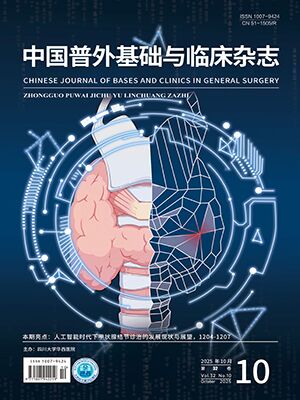| 1. |
Sung H, Ferlay J, Siegel RL, et al. Global cancer statistics 2020: GLOBOCAN estimates of incidence and mortality worldwide for 36 cancers in 185 countries. CA Cancer J Clin, 2021, 71(3): 209-249.
|
| 2. |
Moreno-Aspitia A. Neoadjuvant therapy in early-stage breast cancer. Crit Rev Oncol Hematol, 2012, 82(2): 187-199.
|
| 3. |
Fisher B, Gunduz N, Coyle J, et al. Presence of a growth-stimulating factor in serum following primary tumor removal in mice. Cancer Res, 1989, 49(8): 1996-2001.
|
| 4. |
Siegel RL, Miller KD, Wagle NS, et al. Cancer statistics, 2023. CA Cancer J Clin, 2023, 73(1): 17-48.
|
| 5. |
Boughey JC, Suman VJ, Mittendorf EA, et al. Sentinel lymph node surgery after neoadjuvant chemotherapy in patients with node-positive breast cancer: the ACOSOG Z1071 (Alliance) clinical trial. JAMA, 2013, 310(14): 1455-1461.
|
| 6. |
Early Breast Cancer Trialists’ Collaborative Group (EBCTCG). Long-term outcomes for neoadjuvant versus adjuvant chemotherapy in early breast cancer: meta-analysis of individual patient data from ten randomised trials. Lancet Oncol, 2018, 19(1): 27-39.
|
| 7. |
Fisher B, Brown A, Mamounas E, et al. Effect of preoperative chemotherapy on local-regional disease in women with operable breast cancer: findings from National Surgical Adjuvant Breast and Bowel Project B-18. J Clin Oncol, 1997, 15(7): 2483-2493.
|
| 8. |
Rastogi P, Anderson SJ, Bear HD, et al. Preoperative chemotherapy: updates of National Surgical Adjuvant Breast and Bowel Project Protocols B-18 and B-27. J Clin Oncol, 2008, 26(5): 778-785.
|
| 9. |
Stankowski-Drengler TJ, Livingston-Rosanoff D, Schumacher JR, et al. Breast cancer outcomes of neoadjuvant versus adjuvant chemotherapy by receptor subtype: a scoping review. J Surg Res, 2020, 254: 83-90.
|
| 10. |
van Nes JG, Putter H, Julien JP, et al. Preoperative chemotherapy is safe in early breast cancer, even after 10 years of follow-up; clinical and translational results from the EORTC trial 10902. Breast Cancer Res Treat, 2009, 115(1): 101-113.
|
| 11. |
Goldhirsch A, Winer EP, Coates AS, et al. Personalizing the treatment of women with early breast cancer: highlights of the St Gallen International Expert Consensus on the primary therapy of early breast cancer 2013. Ann Oncol, 2013, 24(9): 2206-2223.
|
| 12. |
Qiu P, Sheng J. A two-stage procedure for comparing hazard rate functions. J R Stat Soc Series B Stat Methodol, 2008, 70(1): 191-208.
|
| 13. |
van der Hage JA, van de Velde CJ, Julien JP, et al. Preoperative chemotherapy in primary operable breast cancer: results from the European Organization for Research and Treatment of Cancer Trial 10902. J Clin Oncol, 2001, 19(22): 4224-4237.
|
| 14. |
Mamtani A, Barrio AV, King TA, et al. How often does neoadjuvant chemotherapy avoid axillary dissection in patients with histologically confirmed nodal metastases? Results of a prospective study. Ann Surg Oncol, 2016, 23(11): 3467-3474.
|
| 15. |
Yau C, Osdoit M, van der Noordaa M, et al. Residual cancer burden after neoadjuvant chemotherapy and long-term survival outcomes in breast cancer: a multicentre pooled analysis of 5 161 patients. Lancet Oncol, 2022, 23(1): 149-160. doi: 10.1016/S1470-2045(21)00589-1.
|
| 16. |
Li X, Dai D, Chen B, et al. Oncological outcome of complete response after neoadjuvant chemotherapy for breast conserving surgery: a systematic review and meta-analysis. World J Surg Oncol, 2017, 15(1): 210. doi: 10.1186/s12957-017-1277-2.
|
| 17. |
Read RL, Flitcroft K, Snook KL, et al. Utility of neoadjuvant chemotherapy in the treatment of operable breast cancer. ANZ J Surg, 2015, 85(5): 315-320.
|
| 18. |
Shang Y, Wang X, Liu Y, et al. Comparing survival outcomes between neoadjuvant and adjuvant chemotherapy within T2N1M0 stage hormone receptor-positive, HER2-negative breast cancer: a retrospective cohort study based on SEER database. Breast Cancer, 2024, 31(4): 684-694.
|
| 19. |
施杰, 李云涛, 高海燕. 腋窝淋巴结阳性Luminal A型乳腺癌患者新辅助与辅助化疗的预后及影响因素分析. 中华乳腺病杂志(电子版), 2023, 17(6): 353-361.
|
| 20. |
Fisher B, Bryant J, Wolmark N, et al. Effect of preoperative chemotherapy on the outcome of women with operable breast cancer. J Clin Oncol, 2023, 41(10): 1795-1808.
|
| 21. |
Boughey JC, Hoskin TL, Goetz MP. Neoadjuvant chemotherapy and nodal response rates in luminal breast cancer: efects of age and tumor Ki67. Ann Surg Oncol, 2022, 29(9): 5747-5756.
|
| 22. |
Colleoni M, Bagnardi V, Rotmensz N, et al. A nomogram based on the expression of Ki-67, steroid hormone receptors status and number of chemotherapy courses to predict pathological complete remission after preoperative chemotherapy for breast cancer. Eur J Cancer, 2010, 46(12): 2216-2224.
|
| 23. |
Copson E, Eccles B, Maishman T, et al. Prospective observational study of breast cancer treatment outcomes for UK women aged 18–40 years at diagnosis: the POSH study. J Natl Cancer Inst, 2013, 105(13): 978-988.
|
| 24. |
Du L, Yau C, Brown-Swigart L, et al. Predicted sensitivity to endocrine therapy for stage Ⅱ–Ⅲ hormone receptor-positive and HER2-negative (HR+/HER2–) breast cancer before chemo-endocrine therapy. Ann Oncol, 2021, 32(5): 642-651.
|
| 25. |
Early Breast Cancer Trialists’ Collaborative Group (EBCTCG). Effects of chemotherapy and hormonal therapy for early breast cancer on recurrence and 15-year survival: an overview of the randomised trials. Lancet, 2005, 365(9472): 1687-1717.
|




